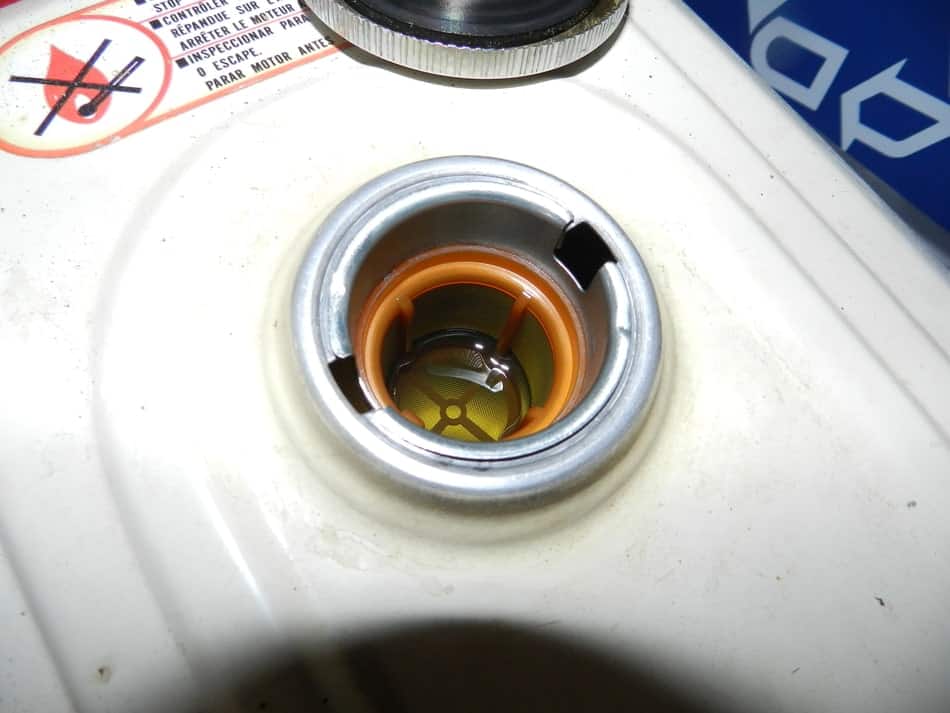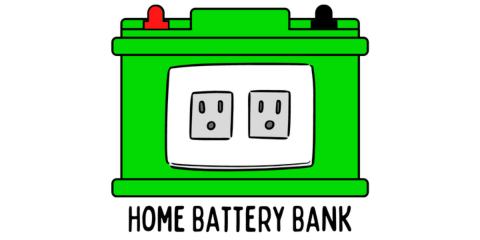Treating gasoline is not the epic controversy that it is made out to be on the internet when you’re wondering which method to take. It’s actually incredibly easy and just takes a few common-sense steps to ensure that your gas will be good to go the next time you’re looking to use it.
How do you store gasoline for long-term storage?
To properly store gasoline long term, add the appropriate amount of stabilizer to gasoline and place in a self-sealing gasoline container. Do not vent your gasoline containers as this will release the most combustible vapors and will oxidize the gasoline. Stored this way, gasoline can easily last up to 2 years.
This stabilizing agent can be mixed with gasoline in a gas can, or mixed and cycled in an engine that already has untreated gas. The brand of stabilizer that you use is not as important (I prefer SeaFoam) as just picking one and making sure to treat the gasoline.
In this article, I’ll cover why you want to stabilize your gasoline, what to do with old and untreated gas, stabilizer types, when and how to stabilize, and some environmental factors to consider.
Why do I need to Stabilize My Gasoline?
To be clear, all gasoline types — whether Ethanol free, diesel, or regular unleaded — will deteriorate over time due to oxidation. Oxygen in the air will react with the gasoline and cause it to lose its volatile properties, and it will cause a chemical reaction in the gas that will lead to residue and deposits to be formed within your engine, carburetor, fuel lines or gas can.
Untreated gasoline should be used up within 2-4 weeks (2 for regular unleaded, 4 for ethanol free).
My article here explains the difference between regular unleaded and ethanol free and which one you should use in a particular application.
Treating gasoline will slow down this process but not solve it forever. Gasoline that is treated should be used up within 1 year of the time of treatment, and treatment should occur on the day you purchase the gasoline.
In a self-sealing container (those produced since 2009), I’ve had stabilized gasoline stored for up to 2 years and it runs just fine.
What if my Gas has been Sitting for a Long Time Untreated?
Treating gasoline after the fact will not revive your gas. The best you can do if your gas is already bad is dispose of it properly by taking it to a hazardous waste treatment center, let it evaporate in small installments of thin pools, or mix with fresh gas (depending on how aged it is and how much you care about your engine).
I would not recommend using really old and untreated gasoline in your critical engines such as your vehicle or generator. However, if you had some old gasoline in a generator you could remove it, mix it with some fresh fuel (1:2 or 1:4 ratio, depending on its age), and use it in a non-critical engine like a lawnmower.
If you’ve had untreated gas sitting for a long time in a generator or other engine, I would recommend removing it all. With generators, you can just remove/open the bolt on the side of the bowl of the carburetor. Make sure the fuel lever is turned on so that fuel will flow from the gas tank to the carburetor. Drain the fuel into an approved container. Another option is to use a hand-pump siphon like the one seen here on Amazon.
It’s hard to tell the damage done without getting into the internals. As a first step, close the bolt that you previously opened, clean the spark plug, and fill the gas tank with treated gasoline (my preference would be Sea Foam since it is designed to clean out engines as well as treat gasoline for oxidation).
Start up the generator and let it run for a half an hour at least and monitor the sound of the engine. If the engine stalls, you’ll have to start the troubleshooting processes. It may be a clogged fuel line or a gummed up carburetor. That’s getting into another subject entirely!
What type of Stabilizer do I need to Use For Long-Term Gasoline Storage?
Internet forums are rife with debate about Stabil vs. Sea Foam, and Sea Foam vs. Star Tron. In truth, if you use your gasoline within a year, they will all work just fine for the purpose of preventing the oxidation of your fuel. That’s not to say that some don’t offer additional benefits, but the ones you’ll find competing with each other will all protect your gas on the basic level.
I have personally used Sea Foam and Stabil and have not had a problem whatsoever with either one. I am now transitioning over to Sea Foam, however, because it has the added benefit of cleaning out the fuel lines and carburetor of my generator when in use.
Also keep in mind that if your engine already has a lot of build-up from bad or old gasoline, that adding Sea Foam will likely break down and dislodge that stuff within your engine. This might result in a clogged line which will lead to engine stalling. It wasn’t the fuel stabilizer itself that stalled your engine, rather the debris within it already that now became loosened due to using a fuel stabilizer.
How to Treat your Gasoline for Storage in a Can
To treat your gasoline before you add it to your engine, I recommend taking the empty gas can, the fuel stabilizer and a funnel if needed to the gas station. Add the appropriate amount of stabilizer to mix with the amount of gasoline you plan on putting in the can.
Do not overfill the can if you intend to store the gasoline! If it is 5 gallons, fill it to the mark on the side of the jug and watch the ticker on the pump that tells you when you reach 5 gallons. The gas can itself needs room to expand and contract with the volatile fumes and temperature changes while in storage.
When sealed, it is NORMAL for your gas can to look bloated in the hot months, and sunken-in during the cold months.
When you’re done, label the gasoline jug with a strip of duct-tape and a magic marker. Write the type of fuel, what it’s been treated with, and the date. Use the fuel before the next year has passed.
You can always add the stabilizer after you return home from the gas station if that suits you. Just make sure to add it right away, since gas begins to really break down after a month or less.
What if Untreated Gas is Already in my Tank?
If fresh gasoline is already in the tank, you’ll need to figure out the capacity of your fuel tank by consulting your owner’s manual and making an educated guess as to how full it is. Add the amount of fuel stabilizer to the tank (a little extra is not going to harm anything).
Now, you have just treated your gas tank but the fuel lines and other parts of the engine are not protected. You will need to start the engine and let it run for at least 10 minutes to get the treated gasoline to cycle throughout.
If you plan on storing this engine for a while without use, I recommend topping off your engine to the recommended max-fill line with treated gasoline to reduce the amount of air in the tank. The more air you have in the gas tank, the more moisture (water) can condensate and mix with the gas as your fuel tank goes through temperature changes during storage.
Do not exceed the recommended max-fill line, as it will leave nowhere for your gas to expand within the tank when your engine gets really hot.
Also, remember that adding fuel stabilizer to gasoline that has not been treated for an extended time will not bring it back to life!

Environmental Conditions and Gas Can Appearance
At high levels, the sun is a detriment to nearly everything. UV rays break down plastics and cause undesirable chemical reactions. Keep your treated gasoline jugs out of direct sunlight and in the shade.
As seasons change, you will see the gas cans shrink and bulge depending on the temperature. During the summer it might look like your plastic gas can will rupture if you don’t vent it. RESIST THE URGE AND DO NOT VENT THE GAS CAN! It is rated to withstand the pressures, and you will release the most volatile properties of the gas if you do that. It’s tempting, I know. Just leave it alone!
If possible, keep your gasoline in a shed or garage that is not attached to your home. If you must keep gasoline in your garage, it is best to limit it to a reasonable level. Most areas will have codes or ordinances regarding this, and your homeowner’s insurance might have a say in it as well.
Keep the gasoline cans (and tools with gasoline in them) away from pilot lights or open flames. If you must keep them in an attached garage, keep the gas along the wall farthest from the shared wall with the house.
Final Thoughts
In the end, it’s not as important which product that you buy to treat your gasoline for storage, it just matters that you do buy one and be sure to mix it with the gas upon purchase. You really can’t go wrong with Stabil or Sea Foam in my opinion.
Just be sure to use your gasoline up within a year. That’s where labeling your gas cans comes in handy so that you know how old each one is. If the fuel is compatible with your car, dump it in after 6 months to a year and refill the can with stabilizer, gasoline and relabel.
Gas will deteriorate quickly if left untreated, and you do not want to risk not having an engine work when you need it most, or damaging that engine because you failed to stabilize it. A bottle of stabilizer only costs a few dollars at most retail stores and will treat many gallons of gasoline. This is a small investment that will save you lots of headaches and repairs down the road!
